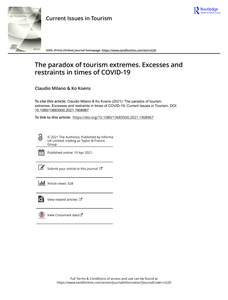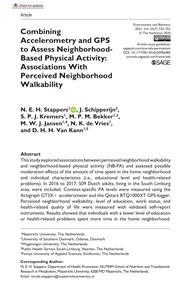Mobility is also a social and economic need. The availability of transport options and the way they are offered may pose various challenges for the mobility of citizens. The biggest challenge is to avoid social and spatial inequalities in urban and also rural areas, which include preventing discrimination against vulnerable and disadvantaged groups. These barriers are not only financial or technical, but also come from political, social and institutional factors. How can mobility management improve access to mobility? How to improve transport links to contribute to combating social exclusion?
DOCUMENT
Aim of this study 1. To examine the development of motor competence over time in primary school children. 2. To study differences in this development according to the SES of the child’s school district.
DOCUMENT

An activity-friendly environment may increase physical activity (PA) levels and decrease sedentary behavior (SB). This study investigated associations between socio-demographic characteristics, health-related quality of life (HRQoL), perceived environment and objectively measured PA outcomes. Socio-demographic characteristics were assessed using a questionnaire and HRQoL was measured using the EQ-5D. The Neighborhood Environment Walkability Scale (NEWS-A) was used to assess the perceived environment. SB, light PA (LPA) and moderate-to-vigorous PA (MVPA) were measured using the Actigraph GT3X+. Data from 622 Dutch adults were used in multivariate linear regression analyses to investigate associations between NEWS-A and PA outcomes. Analyses were controlled for socio-demographic characteristics and HRQoL. The presence of attractive buildings was associated with less SB ( = ?0.086, p < 0.01) and more MVPA ( = 0.118, p < 0.01). Presence of destinations within walking distance was also positively associated with MVPA ( = 0.106, p < 0.01). Less crime was associated with less MVPA ( = 0.092, p < 0.05). Interactions between personal and environmental characteristics showed that the absence of PA-hindering characteristics (e.g., heavy traffic) was associated with less SB and more MVPA, but only for residents with problems regarding pain and usual activities. The presence of PA-facilitating characteristics (e.g., aesthetics and destinations) was associated with less SB, more LPA and more MVPA but only for the more advantaged people in society. Results suggest that to reduce health inequalities, it would be more helpful to remove barriers rather than introduce PA facilitating characteristics.
DOCUMENT

Presentatie intreerede Lampros Stergioulas
DOCUMENT
BACKGROUND: Reducing inequalities in physical activity (PA) and PA-associated health outcomes is a priority for public health. Interventions to promote PA may reduce inequalities, but may also unintentionally increase them. Thus, there is a need to analyze equity-specific intervention effects. However, the potential for analyzing equity-specific effects of PA interventions has not yet been sufficiently exploited. The aim of this study was to set out a novel equity-specific re-analysis strategy tried out in an international interdisciplinary collaboration.METHODS: The re-analysis strategy comprised harmonizing choice and definition of outcomes, exposures, socio-demographic indicators, and statistical analysis strategies across studies, as well as synthesizing results. It was applied in a collaboration of a convenience sample of eight European PA intervention studies in adults aged ≥45 years. Weekly minutes of moderate-to-vigorous PA was harmonized as outcome. Any versus no intervention was harmonized as exposure. Gender, education, income, area deprivation, and marital status were harmonized as socio-demographic indicators. Interactions between the intervention and socio-demographic indicators on moderate-to-vigorous PA were analyzed using multivariable linear regression and random-effects meta-analysis.RESULTS: The collaborative experience shows that the novel re-analysis strategy can be applied to investigate equity-specific effects of existing PA interventions. Across our convenience sample of studies, no consistent pattern of equity-specific intervention effects was found. Pooled estimates suggested that intervention effects did not differ by gender, education, income, area deprivation, and marital status.CONCLUSIONS: To exploit the potential for equity-specific effect analysis, we encourage future studies to apply the strategy to representative samples of existing study data. Ensuring sufficient representation of 'hard to reach' groups such as the most disadvantaged in study samples is of particular importance. This will help to extend the limited evidence required for the design and prioritization of future interventions that are most likely to reduce health inequalities.
DOCUMENT
This paper seeks to highlight underlying issues of the tourism system that have led to tourism extremes of too much or too little tourism. Five phases are recognized that reflect different ways of dealing with too much tourism over time, after which the impact of a sudden lack of tourism is investigated in light of future renewal processes. This discussion highlights the remarkable capacity of the tourism industry to adjust to rapidly changing circumstances and crises, even when these cause anguish to individuals and within societies at large. The paper thus seeks to contextualize the current discussions regarding the transformation of tourism post COVID-19. It highlights the complexity of changing a tourism that multiple stakeholders depend on or have grown accustomed to. To come to a more balanced tourism, it is necessary to not only come up with alternative visions and strategies, but also to engage with the political economy nature of tourism development. A future research agenda should therefore also discuss facets of entangled power, social exclusion, inequalities and class differences to come to new reference points of what actually constitutes a more inclusive tourism success.
MULTIFILE

This study explored associations between perceived neighborhood walkability and neighborhood-based physical activity (NB-PA) and assessed possible moderation effects of the amount of time spent in the home neighborhood and individual characteristics (i.e., educational level and health-related problems). In 2016 to 2017, 509 Dutch adults, living in the South Limburg area, were included. Context-specific PA levels were measured using the Actigraph GT3X+ accelerometer and the Qstarz BTQ1000XT GPS-logger. Perceived neighborhood walkability, level of education, work status, and health-related quality of life were measured with validated self-report instruments. Results showed that individuals with a lower level of education or health-related problems spent more time in the home neighborhood. The perceived neighborhood walkability only affected NB-PA for individuals spending a relatively large amount of time in their home neighborhood. PA-facilitating features in the home neighborhood, for example, aesthetics, were only associated with more NB-PA for individuals without health-related problems or with a higher level of education.
DOCUMENT

Anthropocentrism is the belief that value is focused on human beings and that all other beings are means to human ends. Related to anthropocentrism, humanism privileges the aim of improvement of human welfare. Humanism has underwritten efforts to expose social injustices and improve the welfare of all human beings. In relation to the environment, post-humanism can be defined by a number of characteristics. First, post-humanism exposes anthropocentrism as an attempt to ignore the behavior in which humans focus on themselves at the expanse of all other species. Second, post-humanism critiques exclusive moral focus on human inequalities in relation to environmental protection, emphasizing that inequality between species should remain within the scope of ethical consideration. Third, post-humanism exposes anthropocentrism as an inadequate basis for environmental action as it criticizes anthropocentrism as ethically wrong as well as pragmatically ineffective. https://onlinelibrary.wiley.com/doi/book/10.1002/9781118924396 LinkedIn: https://www.linkedin.com/in/helenkopnina/
MULTIFILE

The richness of the studies presented is disappearing under a thick sauce of left-wing ideology and perceptions of globalization, making it too easy for ‘the enemy’ to neglect this book. Quotes like ‘To put it crudely, market tyrannies and state despotism have deepened inequalities and abrogate freedom both within and among nations’, are not very helpful in starting a more open debate on the marginalization of young people in different cultures and countries. I think the studies themselves are very convincing and do not need too obvious links to globalizing evil. The research observations are in contrast with the rather blunt social political analyses. The position of social work, given its empowering tradition with regard to excluded groups (such as many of the youth gangs and cultures in this publication), needs to be a self confident approach, focused on giving insight into and improving practices in the life world contexts of young people.
DOCUMENT

Reducing social inequalities in physical activity (PA) has become a priority for public health. However, evidence concerning the impact of interventions on inequalities in PA is scarce. This study aims to develop and test the application of a strategy for re-analyzing equity-specific effects of existing PA intervention studies in middle-aged and older adults, as part of an international interdisciplinary collaboration. This article aims to describe (1) the establishment and characteristics of the collaboration; and (2) the jointly developed equity-specific re-analysis strategy as a first result of the collaboration. To develop the strategy, a collaboration based on a convenience sample of eight published studies of individual-level PA interventions among the general population of adults aged ≥45 years was initiated (UK, n = 3; The Netherlands, n = 3; Belgium, n = 1; Germany, n = 1). Researchers from these studies participated in a workshop and subsequent e-mail correspondence. The developed strategy will be used to investigate social inequalities in intervention adherence, dropout, and efficacy. This will allow for a comprehensive assessment of social inequalities within intervention benefits. The application of the strategy within and beyond the collaboration will help to extend the limited evidence regarding the effects of interventions on social inequalities in PA among middle-aged and older adults.
DOCUMENT